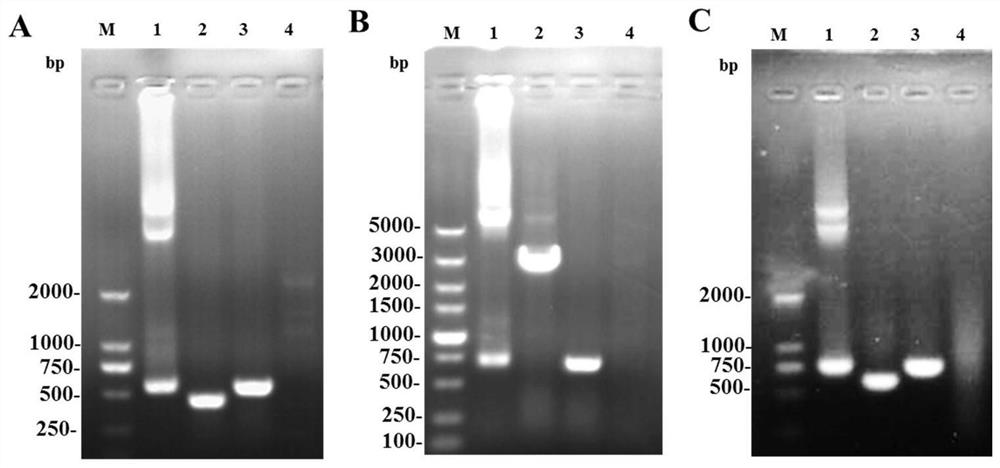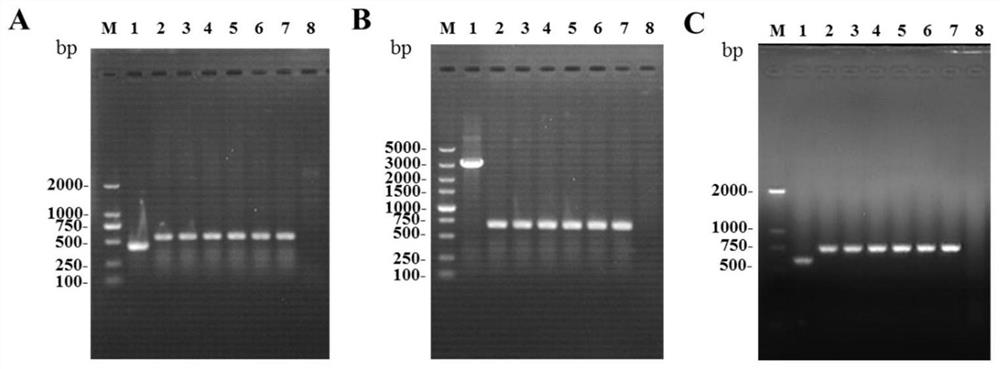A pseudorabies virus tk, ge, gi and gg gene deletion strain and preparation method and application thereof
A technology of pseudorabies virus and pseudorabies virus, which is applied in chemical instruments and methods, methods based on microorganisms, biochemical equipment and methods, etc., can solve the problems of low precision repair rate and off-target, and achieve the reduction of immunogenicity and improvement of Efficiency, Improving the Effect of the Immune Response
- Summary
- Abstract
- Description
- Claims
- Application Information
AI Technical Summary
Problems solved by technology
Method used
Image
Examples
Embodiment 1
[0037] Example 1 Construction of sgRNA expression vector
[0038] In this example, the viral genome sequence was input into the sgRNA online design website (http: / / crispr.mit.edu), the sgRNA sequence with PAM (NGG) was found, and the sgRNA with a low off-target rate was selected, and the construction method of Zhang Feng's laboratory was adopted. It was cloned into pX335 vector, and the sgRNA sequence is shown in Table 1.
[0039] Table 1 sgRNA sequences used to target virus-related genes
[0040]
[0041]
Embodiment 2
[0042] Example 2 Construction of transfer plasmids pcDNA3.1-ΔTK, pSK-ΔgE / gI and pSK-ΔgG
[0043] In this example, the genome of PRV CH16 strain was used as a template to amplify the partial sequences of TK, gE / gI and gG genes, and then respectively digested and ligated into pcDNA3.1(+) or pBluescript II-SK(+) vector to construct transfer Plasmids pcDNA3.1-ΔTK, pSK-ΔgE / gI and pSK-ΔgG. Among them, the simian vacuolar virus 40 (sv40) poly A sequence (SEQ ID NO: 1) was inserted between the left and right homologous sequences of TK; the rabbit globin terminator (Rabbit globinterminator) sequence (SEQ ID NO: 1) was inserted between the left and right homologous sequences of gG :2). The amplification primer sequences are shown in Table 2.
[0044] Table 2 Primer sequences related to transfer plasmid construction
[0045]
Embodiment 3
[0046] Example 3 Extraction of PRV genome
[0047] In this example, PK-15 cells were passaged into T25 cell culture flasks, and 24 hours later, the virus was inoculated into the cells at 1 MOI (multiplicity of infection, MOI). Cell lysate, shake uniformly to lyse all cells, place on ice for 20min, and pour into a 2mL EP tube. Add 660 μL of 5M NaCl dropwise, mix gently, and place on ice for 5 h or in a 4°C refrigerator overnight. Centrifuge at 12000rpm for 30min at 4°C. Pipette the supernatant into a new 2mL EP tube with a pipette tip cut off, add an equal volume of DNA extraction solution, gently invert the EP tube for 5min, centrifuge at 12000rpm at 4°C for 10min, and repeat the DNA extraction solution to extract protein 3 times. Change the 1.5mL EP tube, add pre-cooled 2-fold volume of absolute ethanol to the final supernatant, mix gently, and let stand at -20°C for 2h or overnight. Centrifuge at 12000 rpm for 10 min at 4°C, discard the supernatant, add pre-cooled 75% ab...
PUM
 Login to View More
Login to View More Abstract
Description
Claims
Application Information
 Login to View More
Login to View More - R&D
- Intellectual Property
- Life Sciences
- Materials
- Tech Scout
- Unparalleled Data Quality
- Higher Quality Content
- 60% Fewer Hallucinations
Browse by: Latest US Patents, China's latest patents, Technical Efficacy Thesaurus, Application Domain, Technology Topic, Popular Technical Reports.
© 2025 PatSnap. All rights reserved.Legal|Privacy policy|Modern Slavery Act Transparency Statement|Sitemap|About US| Contact US: help@patsnap.com



